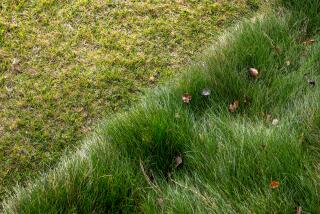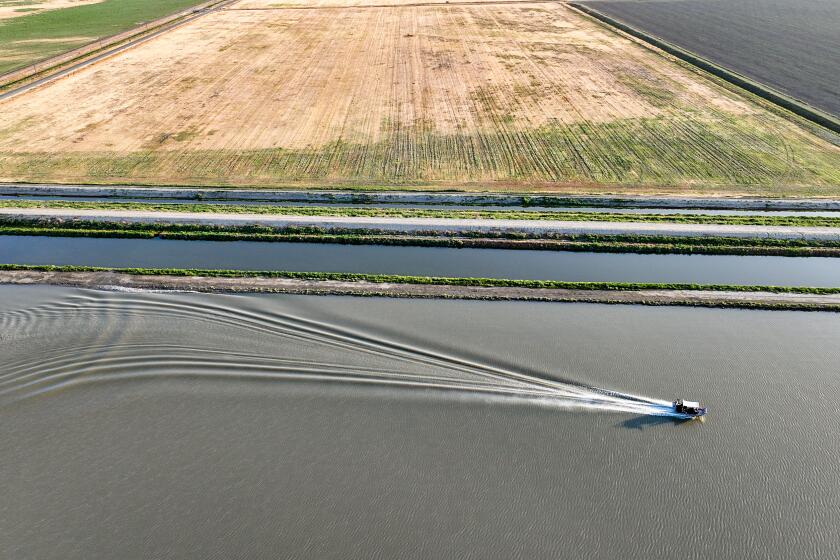California bans watering ‘nonfunctional’ grass in some areas, strengthening drought rules

California water regulators adopted emergency drought rules Tuesday that increase conservation requirements for water suppliers throughout the state and prohibit the watering of grass that is purely decorative at businesses and in common areas of subdivisions and homeowners associations.
The regulations outlaw the use of drinking water for irrigating “nonfunctional” grass at commercial, industrial and institutional properties.
The ban doesn’t apply to yards at individual homes. There are also exemptions for sports fields, grassy areas where people gather, and for watering to keep trees healthy.
The State Water Resources Control Board voted to adopt the emergency drought regulations following an executive order by Gov. Gavin Newsom. The measures also require local water suppliers statewide to activate “Level 2” of their local contingency plans to prepare for a shortage of up to 20%.
“We need to activate Californians and really lean into the conservation that we’re needing to see,” said Joaquin Esquivel, chair of the state water board.
The regulations require each urban water supplier to submit an annual water supply and demand assessment. Each agency that has filed a shortage contingency plan should take steps to reduce water use to prepare for a shortage of between 10% and 20%.
Water agencies that haven’t yet turned in a contingency plan are required to take similar steps, including having a public information campaign focused on conservation and enforcing a rule limiting outdoor watering to two days a week, with limited hours before 10 a.m. or after 6 p.m. The water agencies that haven’t yet submitted a plan supply about 8% of the state’s population.
The regulations define “nonfunctional” turf as grass that is “solely ornamental” and not regularly used for recreational purposes or community events.
“Any part of the golf course that is being used for the game of golf, such as the greens and the fairways, are functional,” said Edward Ortiz, a spokesperson for the state water board. “However, water agencies and golf courses need to evaluate whether other turf on a golf course property is functional or not.”
Areas that are irrigated with recycled wastewater aren’t subject to the grass-watering ban.
The emergency regulations are to remain in effect for a year, and may be extended by the state water board.
Las Vegas is taking a similar step, but on a long-term basis. Last year, the Nevada Legislature passed a law that prohibits the use of Colorado River water for “nonfunctional” grass along streets, at commercial properties such as business parks and shopping centers, and at homeowners associations and apartment complexes. The law takes effect in 2026.
The state water board adopted the rules a day after Newsom met with leaders of large urban water suppliers and urged them to step up efforts to get people to reduce water use. In July, Newsom called for Californians to voluntarily cut water use 15%. But the water savings through March have amounted to just 3.7% less than a 2020 baseline. Water use in cities and towns rose by nearly 19% in March, an especially warm and dry month.
Some who attended the meeting said Newsom called the increase in water use a “black eye.” The governor warned that if conservation efforts don’t improve in the next two months, his administration could be forced to impose mandatory water restrictions throughout the state.
During Tuesday’s meeting, board members heard from representatives of water agencies and others who urged them to avoid a “one-size-fits-all” approach and stressed that some suppliers are better off because they have made progress on conservation and have invested in infrastructure. Some of these areas rely entirely on local water supplies.
Others voiced concerns that the regulations barring the watering of some grasses are punitive toward homeowners associations and would increase costs.
Before adopting the regulations, the state water board made several revisions to accommodate certain special cases. They allowed some water agencies to implement less stringent conservation measures, in line with those of suppliers that haven’t submitted shortage plans to the state, if the agency’s planning documents show they can maintain a reliable supply at least through September 2023; if it doesn’t rely on imported water or heavily use a severely declining groundwater supply; and if its customers are already using less than 55 gallons per person per day — an amount that means only a small number of water suppliers will qualify.
Board members included another revision that allows water agencies to approve a request for watering “nonfunctional” grass if the property owner can certify that it’s a type of low-water-use turf that requires a fraction of the water consumed by standard types of grass.
“We are in this unprecedented drought. We need to act like it,” board member Laurel Firestone said, supporting the regulations. “We need to be making sure that all hands are on deck. And also we need to use this opportunity to accelerate the adaptation to efficiency that is going to be needed in this new normal.”
The severe drought, now in its third year in California, is one of the most extreme on record and has been worsened by hotter temperatures with global warming.
Across the western U.S., scientists have found that the extreme dryness since 2000 has become the driest 22-year period in at least 1,200 years, a megadrought that research shows is being intensified by climate change. Scientists have described the trend as aridification, saying the West must prepare for heat-driven drying to continue as temperatures climb with the burning of fossil fuels and rising levels of greenhouse gases.
“I wish we wouldn’t say drought because this is climate change. Drought actually ends. And we’re continually seeing these extremes of drier and drier years,” commented Connor Everts, executive director of the Southern California Watershed Alliance. “And if we don’t account for that on a long-term basis, we’re going to continue to have these discussions.”
In the meantime, cities and water districts in Southern California are offering customers rebates to help cover the costs of converting lawns to drought-tolerant landscaping.
“It’s time to actually, if not kill our lawns, reduce the impact of inappropriate landscapes in this state as we get drier and drier,” Everts said. “We have to react to the reality that we’re in.”
The Metropolitan Water District in April declared a water shortage emergency and ordered restrictions on outdoor watering in parts of Los Angeles, Ventura and San Bernardino counties that rely on the State Water Project, which transports water southward from the Sacramento-San Joaquin River Delta. The water restrictions are set to take effect June 1 and are aimed at reducing water use by about 35%.
Esquivel said the increased aridity that California faces requires a transition.
“Conservation isn’t a destination. It’s a journey. It’s continuing to ensure that we don’t have waste in our system, that our water values reflect the great cost that it takes to move, to treat, to be able to deliver safe water across the state,” Esquivel said. “I think the signs are clear about the climate that we all are now living in, and what we’re going to have to do to continue to adapt — and do something that California has always done, which is innovate.”
More to Read
Start your day right
Sign up for Essential California for news, features and recommendations from the L.A. Times and beyond in your inbox six days a week.
You may occasionally receive promotional content from the Los Angeles Times.







